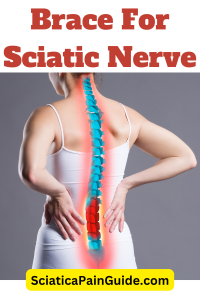Brace For Sciatic Nerve
Discover the benefits of using a brace for sciatic nerve relief. Dive into reviews, expert advice, and find the best fit for your needs. Sciatica pain can be debilitating, and I understand that better than anyone. As someone who’s spent countless hours researching, trying out different remedies, and consulting experts, I’ve gathered some insights on the brace for the sciatic nerve that I’m sure will be valuable for you.
Understanding What Is Sciatica
Sciatica isn’t a condition but a symptom of an underlying issue. It refers to pain that radiates along the path of the sciatic nerve, the longest nerve in your body, running from your lower back, through your hips and buttocks, and down each leg.
Causes Of Sciatica
Sciatica arises from various causes. A herniated disc in the spine can press on the sciatic nerve. Spinal stenosis, where the spinal canal narrows, may compress the nerve. Spondylolisthesis, a condition where one vertebra slips over another, can cause pressure. Piriformis syndrome, where the piriformis muscle irritates the nerve, can trigger sciatica. Trauma from accidents can injure the nerve directly. Prolonged sitting or a tumor can also cause sciatic pain.
Symptoms Of Sciatica Affect Only One Side Of The Body
Sciatica typically affects only one side of the body. Symptoms include sharp pain in the lower back or buttock and travel down the hip and leg. This pain can range from a mild ache to a sharp burning sensation. Some people experience tingling, numbness, or muscle weakness in the affected leg or foot. Coughing, sneezing, or prolonged sitting can intensify the pain. It’s essential to recognize these symptoms and seek medical attention.
Diagnosing Sciatica
Diagnosing sciatica involves several steps. Initially, doctors review the patient’s medical history and symptoms. A physical examination then assesses nerve function by checking reflexes, strength, and pain sensations. Straight-leg-raise tests help pinpoint the affected nerve root. Imaging tests, such as X-rays, MRI, and CT scans, reveal spinal conditions that may be causing the pain. Electromyography (EMG) determines if nerve compression affects muscle function. These combined assessments help doctors diagnose and plan treatment.
Brace For Sciatica Nerve
Sciatica nerve pain can be incredibly debilitating, but you can take proactive steps to brace for it:
- Focus on proper posture to align your spine correctly.
- Engage in regular exercise like walking or swimming to strengthen your back muscles.
- Consult your doctor for appropriate medications and possibly physical therapy.
- Consider using a lumbar support when sitting for long periods.
- Use hot or cold packs to relieve acute pain episodes.
Keeping these strategies in mind will help you better manage the discomfort and limitations that sciatica can bring.
Do Sciatic Nerve Braces Work?
The effectiveness of sciatic nerve braces varies among individuals. Generally, a brace aims to stabilize the affected area, whether the lower back, hip, or leg, to reduce nerve pressure and promote proper alignment. By doing so, the brace can alleviate sciatica symptoms, such as pain and numbness. However, a brace is often part of a broader treatment plan, including medication, physical therapy, and lifestyle changes. Before using any brace, consult your healthcare provider for an accurate diagnosis and tailored treatment recommendations. While some find relief, others may require more intensive interventions.
Can You Wrap A Sciatic Nerve?
Wrapping the sciatic nerve is not advisable, as it could worsen symptoms or cause additional issues. However, compression garments or braces target areas affected by sciatic pain. Always consult a healthcare provider for accurate diagnosis and personalized treatment recommendations before wrapping or bracing.
Should You Wear A Back Brace For Sciatica
The Role Of A Sciatic Nerve Brace
How A Sciatic Nerve Brace Works
Braces act as a supportive device that relieves pressure from the sciatic nerve. Compressing the area around the lower back and hips helps reduce pain and inflammation.
Benefits Of Using A Sciatic Nerve Brace
The benefits of using a brace are plentiful. They help maintain proper posture, limit movements that may cause further pain, and stimulate blood flow to aid recovery.
When To Use A Sciatic Nerve Brace
While a brace can be an effective aid, it’s not always necessary. A brace could be a good option if you experience severe pain or if your symptoms continue despite other treatments.
Exercise With A Brace For Sciatic Nerve
You can exercise with a brace for the sciatic nerve. In fact, specific exercises may be recommended to help manage your sciatica symptoms and strengthen your back and core muscles.
The brace can provide additional support and stability during these exercises, helping to prevent further injury or aggravation of the sciatic nerve.
However, getting clearance from a healthcare professional before starting an exercise routine is essential, especially if you’re dealing with sciatica or other back-related issues.
Considering your unique condition, they can advise on what exercises are safe and beneficial for you. Also, it’s necessary to ensure that the brace is fitted correctly to avoid discomfort or counterproductive effects during your workout.
Remember, while a brace can provide support during physical activity, it is not a replacement for proper exercise form and should not be relied upon to correct poor exercise technique.
Different Types Of Braces For Sciatica Nerve
Braces for sciatica nerve pain help maintain good posture and exercise regularly. Consult your doctor for medication and consider physical therapy. Use lumbar support when sitting and apply hot or cold packs for immediate relief. Here are the different types of braces:
Leg Brace For Sciatica Nerve Pain
To manage sciatica nerve pain, use a leg brace as directed by your healthcare provider. The brace stabilizes your leg, alleviates pressure on the nerve, and promotes correct posture. Consult your doctor for proper fit and usage guidelines.
Lumbar Braces For Sciatica Nerve
Lumbar braces support the lower back, limiting movement and relieving pressure on the sciatic nerve. They’re great for people with a job requiring heavy lifting.
Pelvic Belts Braces For Sciatica Nerve
Pelvic belts work by compressing your hips and lower back, providing support and reducing strain. They’re perfect for individuals who stand for long periods.
Knee Braces For Sciatica Nerve
Knee braces help by limiting excessive movements and alleviating stress on the knee and, consequently, the sciatic nerve. They’re ideal for athletes and those who enjoy physical activities.
Calf Brace For Sciatica
A calf brace can provide targeted support. It stabilizes the calf muscle, reduces nerve pressure, and promotes proper leg alignment. Always consult your doctor for accurate diagnosis and personalized treatment advice before using a brace.
Hip Braces For Sciatica Nerve
Use a hip brace as your healthcare provider recommends to alleviate sciatica nerve pain. The brace stabilizes the hip joint, reduces nerve tension, and helps maintain proper alignment. Consult your doctor for appropriate fit and usage instructions.
Does A Hip Brace Help Sciatica Pain?
A hip brace can help manage sciatica pain by stabilizing the hip joint and reducing tension on the sciatic nerve. It encourages proper alignment and posture, potentially alleviating the symptoms. However, its effectiveness varies from person to person. Always consult your healthcare provider for an accurate diagnosis and determine if a hip brace suits your condition.
How To Choose A Sciatic Nerve Brace
The choice of brace depends on your lifestyle, pain severity, and personal comfort. Consider factors like adjustability, breathability, durability, and cost. Choosing a sciatic nerve brace requires careful consideration. First, identify the specific location and intensity of your pain. Consult a medical professional to ensure a brace is appropriate for your condition. Next, prioritize a brace that offers adjustability to ensure a snug fit. Look for materials that are breathable and comfortable for extended wear. Read customer reviews to gauge effectiveness and comfort. Consider added features like gel packs for heat or cold therapy. Ensure the brace targets the affected area, either the lower back or hamstring. Finally, if unsure, choose a brace with a return policy, allowing you to test its suitability.
Braces For Different Lifestyle Needs
Selecting a sciatic brace tailored to your lifestyle is crucial. For athletes, opt for a lightweight, breathable brace that doesn’t restrict movement. Office workers should choose ergonomic braces, promote good posture, and fit seamlessly under clothing. Travelers might prioritize compact, foldable designs for easy packing. Pick a brace with added lumbar support if you frequently engage in heavy lifting. Those leading an active outdoor lifestyle should consider water-resistant and durable materials. For prolonged wear, prioritize comfort and skin-friendly fabrics. Always ensure your brace offers the necessary support and adjustability. Matching your brace to your lifestyle maximizes its benefits and convenience.
Best Brace For Sciatica Nerve Pain
The best brace for sciatica nerve pain largely depends on the individual’s specific symptoms and needs. Lumbar braces support the lower back. Hip braces focus on hip alignment, and leg or calf braces stabilize the lower extremities. These braces aim to reduce pressure on the sciatic nerve, promote correct posture, and alleviate pain. Material, fit, and adjustability are key factors when choosing a brace. Medical-grade braces often provide the most effective support. Always consult your healthcare provider for a proper diagnosis and to discuss if a brace is appropriate for your condition as part of a comprehensive treatment plan.
Treating Sciatica Without Braces

Treating sciatica without braces involves various methods. First, engage in targeted exercises to strengthen the back and core muscles. Physical therapists can provide tailored routines for pain relief. Apply heat or cold packs to the affected area to reduce inflammation and ease pain. Over-the-counter pain relievers, like ibuprofen, can alleviate discomfort. Maintain good posture when sitting and standing to reduce pressure on the sciatic nerve. Regularly stretch the lower back, hips, and legs to promote flexibility. Opt for low-impact exercises, such as swimming or walking, to stay active without aggravating the condition. Finally, consider acupuncture or massage therapy as alternative treatments to address underlying muscle tension.
Other Therapeutic Options
In addition to braces, other therapeutic options can help manage sciatica. These include yoga, stretches, and maintaining a healthy weight.
Yoga
Yoga can help manage sciatica by strengthening and stretching muscles supporting the spine and relieving pressure on the sciatic nerve. Specific poses improve posture, flexibility, and alignment. Yoga’s mindful breathing aids in managing pain and reducing stress. Regular practice promotes a healthier spine and reduces the likelihood of future sciatic flare-ups, contributing to overall well-being.
Stretching Exercises
Stretching exercises can help manage sciatica by increasing flexibility, relieving tightness, and reducing pressure on the sciatic nerve. Regular stretching of the lower back, hips, buttocks, and hamstrings can alleviate symptoms. It also improves posture and encourages healthier movement patterns, reducing the likelihood of future flare-ups. Always perform stretches correctly to avoid exacerbating symptoms.
Maintaining A Healthy Weight
Maintaining a healthy weight can help manage sciatica by reducing pressure on the spine and thus, the sciatic nerve. Extra weight, especially around the midsection, can alter spinal alignment and posture, exacerbating sciatica symptoms. A healthy diet and regular exercise not only help in weight management but also promote overall spine health and well-being.
Best Way To Stop Sciatic Nerve Pain
The best way to stop sciatic nerve pain varies among individuals, but a multi-faceted approach often proves the most effective. Prioritize proper posture and spinal alignment to reduce nerve pressure. Engage in regular, low-impact exercises like swimming or walking to strengthen your back and core muscles. Consider taking anti-inflammatory medications as prescribed by your healthcare provider. Physical therapy can offer targeted exercises that alleviate symptoms. In severe cases, steroid injections or even surgical interventions might be necessary. Always consult a healthcare professional for a tailored treatment plan, as underlying issues can differ and require specific medical attention.
When To Seek Medical Help
Seek medical help if you experience worsening pain, increased numbness, or reduced mobility using a sciatica brace. These could indicate improper fit or an underlying issue that requires immediate attention. Also consult a healthcare provider if the brace causes skin irritation or if your symptoms persist despite prolonged use. Early professional intervention often results in more effective treatment.
Brace For Sciatic Nerve – Conclusion
As a fellow enthusiast in managing sciatica, I know the pain and discomfort it can bring. That’s why I recommend considering a sciatic nerve brace as an effective solution. But remember, a brace is not a cure but a means to manage your symptoms. Always consult with a healthcare professional before starting any new treatment.
Please note that this article should not replace professional medical advice. Consult a healthcare professional for an accurate diagnosis and tailored treatment plan.
Frequently Asked Questions (FAQs)
What is the best brace for sciatic nerve pain?
There isn’t a ‘best’ brace universally. It depends on your personal circumstances and lifestyle. However, lumbar braces, pelvic belts, and knee braces are all excellent choices.
Can a brace cure sciatica?
No, a brace is not a cure for sciatica. It’s a tool to help manage symptoms and improve your quality of life.
How long should I wear a sciatic nerve brace?
The length of time varies based on your personal needs and the severity of your pain. Consult with a healthcare professional for advice tailored to your condition.
Can I wear a sciatic nerve brace while sleeping?
While some people find relief in wearing a brace to bed, it isn’t typically recommended as it could restrict blood flow. It’s best to consult with a healthcare professional.
Will a knee brace help with sciatica pain?
A knee brace may relieve sciatica pain by stabilizing the joint and promoting proper alignment. However, its effectiveness varies from person to person. Consult your healthcare provider for a diagnosis and determine if a knee brace suits you.
Are there any risks associated with wearing a sciatic nerve brace?
If used correctly, there are few risks. However, overuse can lead to muscle atrophy. Always follow the advice of a healthcare professional.





